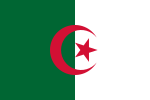Algerian wine
| Part of a series on the |
| Culture of Algeria |
|---|
 |
| People |
| Mythology |
| Art |


Algerian wine is wine made in Algeria. While not a significant force on the world's wine market today, Algeria has played an important role in the history of wine. Algeria's viticultural history dates back to its settlement by the Phoenicians and continued under Algeria's rule by the Roman empire. Just prior to the Algerian War of Independence, Algerian wine (along with the production of Morocco and Tunisia) accounted for nearly two-thirds of the total international wine trade. With as much land under vine as the countries of Germany and South Africa, Algeria continues to maintain a wine industry with over 70 wineries in operation.[1]
History
The roots of Algerian winemaking can be traced to the settlement of the Phoenicians and the influences of nearby Carthage. Under Roman rule, winemaking continued until the Muslim conquests of North Africa in the 7th and 8th centuries. During this time the wine industry was severely limited due to the prohibition of alcohol under Islamic dietary laws. When Algeria came under French rule in 1830 vineyards were replanted in order to serve the needs of the local pieds-noir. When the phylloxera epidemic destroyed the French vineyards in the mid-19th century, Algerian wine exports into France filled the void. An influx of winemakers from the German wine region of Baden brought with them more modern winemaking techniques and helped to increase the overall quality of Algeria wine. Even after the French resumed normal levels of wine production, Algerian wine was still widely used in regions like the Languedoc as a blending component that added color and strength to the wines.[1]
The high point of the Algerian wine industry came in the late 1930s when over 4,000 square kilometres (1,500 sq mi) was producing more 2,100 megalitres (550,000,000 US gal) of wine. By the 1950s, together with Tunisia and Morocco, Algerian wine accounted for nearly two thirds of the wine that was internationally traded. To a large extent, Algerian red wine was used for blending with red wine from the south of France, since Algerian wine was deeper in colour and higher in alcohol than the French wines produced from Aramon grapes.[1] The dominant grape variety in Algeria at this time was Carignan, which only overtook Aramon in southern France in the 1960s.[2]
By the time of Algerian independence in 1962, over a dozen areas were granted Vin Délimité de Qualité Superieure (VDQS) status by the French. Following independence, the wine industry was hard hit by the loss of the French settlers and the French army who provided a sizable domestic market for the wine. France also greatly reduced the amount of exports it was accepting, forcing Algerian wineries to look elsewhere for a market. In 1969, the Soviet Union agreed to buy 500 megalitres (130,000,000 US gal) a year till 1975 at prices far below market value for the wines. Many Algerian government officials thought it was inappropriate for an Islamic country to be so economically dependent on alcohol production and encouraged vineyard owners to convert their land into other agricultural crops such as cereal or table grapes. Urban expansion in areas such as the fertile Mitidja plain behind Algiers further reduced the number of vineyards in Algeria. At the turn of the 21st century, efforts were underway to revive the Algerian wine industry but so far very little Algerian wine is on the international market.[1]
Climate and wine regions
All of Algeria's vineyards are located in the Hauts Plateaux region extending towards the Moroccan border. Bordering the sea, this region has a typical Mediterranean climate with mild winters and dry, hot summers and is very similar to the southern wine regions of Spain. Rainfall averages around 600 millimetres (24 in) in the regions east of Algiers to 400 millimetres (16 in) in the western regions closer to Morocco. The main wine producing areas are located in the provinces of Aïn Témouchent, Mascara, Mostaganem, Sidi Bel Abbès and Tlemcen. Algeria's Office National de Commercialisation des Produits Viti-vinicoles (ONCV) list seven quality wine production zones that may appear on Algerian wine labels.[1]
Grapes and wine
During the peak of Algerian wine production, the main grapes of the region was Carignan, Cinsaut and Alicante Bouschet. Despite not having Pinot noir or otherwise resembling Burgundian wine, blends of these grapes were often labeled as burgundy. In recent times, Clairette blanche and Ugni blanc have become the dominant grape varieties with some smaller plantings of Cabernet Sauvignon, Chardonnay, Merlot, Mouvedre and Syrah. Algerian wines are characterized by their overripe fruit, high alcohol and low acidity. The grapes often go through a short fermentation process and are bottled after little to no oak aging.[1]
See also
References
- ^ a b c d e f Jancis Robinson, ed. (2006). "Algeria". Oxford Companion to Wine (Third ed.). Oxford: Oxford University Press. pp. 11–12. ISBN 0-19-860990-6.
- ^ Jancis Robinson, ed. (2006). "Carignan". Oxford Companion to Wine (Third ed.). Oxford: Oxford University Press. p. 139. ISBN 0-19-860990-6.
